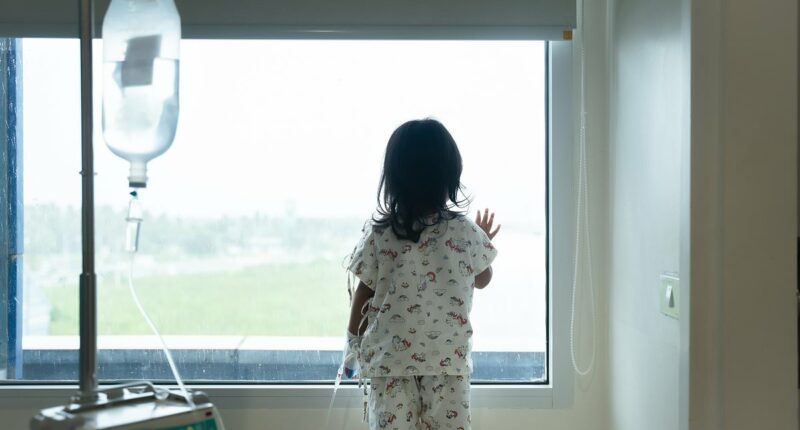Share this @internewscast.com
Radiation exposure from ‘overused’ medical scans may triple the risk of cancer in children, a government-funded study suggests.
Annually, around 18 percent of the American population, approximately 61 million individuals, undergo imaging procedures such as CT scans, which employ radiation to develop comprehensive images of the body’s interior.
These tests are essential for identifying injuries, long-term illnesses, and cancer; however, frequent scans can lead to a build-up of small amounts of radiation in the body, which is recognized as a carcinogen.
Considering these risks, researchers in California analyzed data from nearly four million children across the US and Canada to explore how radiation impacts cancer risk.
The study revealed that roughly one in 10, totaling about 3,000 cases, of childhood blood cancers such as leukemia and lymphoma could be linked to radiation exposure from diagnostic tests like CT scans.
In fact, undergoing just one or two head CT scans was associated with almost doubling the likelihood of developing cancer. Moreover, as the number of scans increased over time, children were over three times more likely to receive a cancer diagnosis compared to those who didn’t undergo these tests.
The researchers propose that eliminating unnecessary imaging procedures and reducing radiation doses could potentially prevent about one in 10 blood cancers in young people.
Using other methods like ultrasound or MRI, they said, could provide a feasible alternative.

A new study from researchers in California found regular scans using radiation could increase a child’s risk of cancer by 3.5 times (stock image)
Dr Rebecca Smith-Bindman, first study author and radiologist at the University of California San Francisco, said: ‘Children are particularly vulnerable to radiation-induced cancer due to their heightened radiosensitivity and longer life expectancy.
‘While medical imaging can be lifesaving, our findings underscore the critical need to carefully evaluate and minimize radiation exposure during pediatric imaging to safeguard children’s long-term health.
‘This involves ensuring that imaging is performed only when it provides essential information for the child’s care and, in cases such as CT scans, using the lowest possible radiation doses.’
About 15,000 children in the US are diagnosed with cancer every year, with the most common form being leukemia, accounting for around 30 percent of US diagnoses per year.
Roughly 1,600 American children die of cancer each year.
Recent research also shows childhood cancers have increased by about 35 percent over the last half-century, which experts have suggested could be due not only to better diagnostic tools but also increased environmental exposures like radiation and pollution.
The new study, published Wednesday in the New England Journal of Medicine, followed a cohort of 3.7million children born between 1996 and 2016 across six US healthcare systems and Ontario, Canada.
The participants were followed from birth until they either: were diagnosed with cancer or a benign tumor, ended healthcare coverage, turned 21 or until the study’s end date of December 31, 2017.

The above shows the relative risks for blood cancers in children according to cumulative radiation exposure
Half of the participants were male, and the largest group (43 percent) were born between 1996 and 2004, and 4,916 (0.1 percent) died before the end of the study.
Of the participants, 2,961 were diagnosed with blood cancer during the study period. Eight in 10 cases were lymphoma, while leukemia and bone marrow cancer accounted for 15.5 percent. The remainder were rare cancers of the white blood and immune cells.
About 58 percent of cancer patients were males, and just over half the cancers were diagnosed in children under five years old.
The researchers found for children who underwent a head CT, about 25 percent of their cancers could be attributed to radiation exposure.
Additionally, getting one or two CT scans of the head was associated with a 1.8-fold increased risk of blood cancer, and receiving repeated scans increased the risk 3.5 times.
The researchers wrote: ‘In our cohort of children and adolescents, we estimated that medical imaging was associated with 10.1 percent of hematologic cancers.’
The risk comes from the unregulated radiation exposure that varies widely machine-to-machine.
CT scans can be life-saving tests, catching disease or bleeding early enough to be treated. They also used to diagnose and monitor diseases like cancer and bone injuries, as well as to assist in surgeries and evaluate efficacy of certain treatments.
However, experts say they are sometimes overprescribed and performed unnecessarily, potentially because of the money-making opportunities for the hospitals, as the tests are very expensive, or out of doctors’ fears of missing a diagnosis and being sued.

The above shows the risk of blood cancers after exposure to radiation
Radiation is a known carcinogen found to damage the DNA molecules within cells, causing them to multiple out of control and form cancer cells.
It also generates free radicals, toxic molecules that attack DNA and other compounds within cells, and induces inflammation.
Radiation from tests like CT scans is easily absorbed by the bones, where it travels to bone marrow and increases the risk of blood and bone marrow cancers.
The researchers urgently urged clinicians to only use scans with radiations when necessary instead for an MRI or ultrasound, neither of which use radiation.
Dr Diana Miglioretti, study author and professor at UC Davis Health and chief of the Division of Biostatistics, said: ‘This study provides robust, directly observed evidence of a clear dose-response relationship between radiation from medical imaging and hematologic malignancy risk in children and adolescents.
‘Our findings align with international research highlighting that children are especially radiosensitive.
‘It’s crucial for clinicians to weigh the immediate benefits of imaging against potential long-term health risks and to optimize imaging protocols to minimize radiation exposure.’
The research was funded by the National Cancer Institute (NCI) and grants from the Ontario Ministry of Health and Long-Term Care.
Previous research from Dr Smith-Bindman estimated that more than 100,000 new cancers will have been caused by CT scans from exams done in 2023 alone.
The research, published in April, estimated ‘CT-associated cancer could eventually account for five percent of all new cancer diagnoses annually.’















